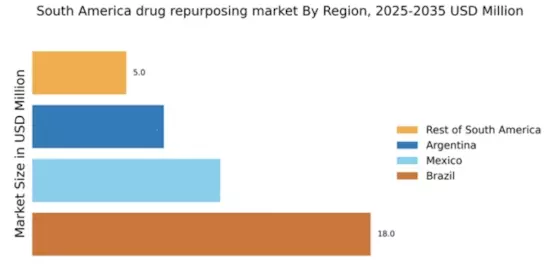Rising Healthcare Costs
The escalating costs associated with healthcare in South America are driving interest in the drug repurposing market. As healthcare expenditures continue to rise, stakeholders are increasingly seeking cost-effective solutions to address various medical conditions. Drug repurposing offers a viable pathway to reduce development costs, as existing drugs can be utilized for new therapeutic indications. This approach not only shortens the time to market but also minimizes the financial burden on healthcare systems. In South America, where healthcare budgets are often constrained, the potential for repurposed drugs to provide affordable treatment options is particularly appealing. The drug repurposing market is thus positioned to benefit from this trend, as it aligns with the need for innovative yet economical healthcare solutions.
Advancements in Technology
Technological advancements are playing a pivotal role in shaping the drug repurposing market in South America. Innovations in data analytics, artificial intelligence, and bioinformatics are enhancing the ability to identify new therapeutic uses for existing drugs. These technologies facilitate the analysis of vast datasets, enabling researchers to uncover potential repurposing opportunities more efficiently. As a result, the drug repurposing market is experiencing a surge in interest from both public and private sectors. The integration of technology not only accelerates the research process but also improves the accuracy of predictions regarding drug efficacy for new indications, thereby fostering a more robust pipeline of repurposed drugs.
Regulatory Framework Enhancements
The evolving regulatory landscape in South America is positively impacting the drug repurposing market. Regulatory bodies are increasingly recognizing the value of repurposed drugs in expediting access to treatments. Streamlined approval processes and supportive policies are being implemented to facilitate the development and commercialization of repurposed medications. This regulatory support is crucial for the drug repurposing market, as it reduces barriers to entry and encourages investment in this area. By fostering a more favorable regulatory environment, authorities are likely to stimulate innovation and enhance the availability of effective therapies for patients in need.
Growing Burden of Non-Communicable Diseases
The rising prevalence of non-communicable diseases (NCDs) in South America is significantly influencing the drug repurposing market. Conditions such as diabetes, cardiovascular diseases, and cancer are becoming increasingly common, necessitating the development of effective treatment strategies. Drug repurposing presents an opportunity to quickly provide therapies for these diseases by leveraging existing medications. The World Health Organization has indicated that NCDs account for approximately 70% of all deaths in the region, underscoring the urgent need for innovative solutions. The drug repurposing market is likely to thrive as it addresses this growing health crisis, offering a faster and more cost-effective means to combat the rising tide of NCDs.
Increased Investment in Research and Development
Investment in research and development (R&D) is crucial for the growth of the drug repurposing market in South America. Governments and private entities are recognizing the potential of repurposed drugs to address unmet medical needs. As a result, funding for R&D initiatives is on the rise, with a focus on exploring new applications for existing medications. This influx of capital is likely to enhance the capabilities of research institutions and pharmaceutical companies, leading to a more dynamic drug repurposing market. The commitment to R&D not only fosters innovation but also encourages collaboration among stakeholders, further propelling the market forward.


















Leave a Comment